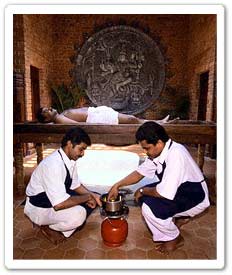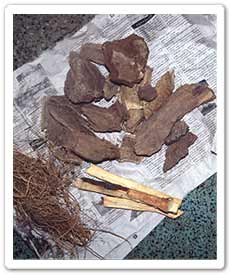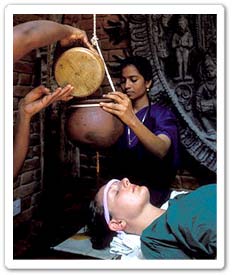Time : Any time of the year. But, the treatment is best during the Monsoons.
"Life (ayu) is the combination (samyoga) of body, senses, mind and reincarnating soul. Ayurveda is the most sacred science of life, beneficial to humans both in this world and the world beyond."
Charaka Samhita, Sutrasthana, 1.42-43.
 What
is Ayurveda ?
What
is Ayurveda ?Ayurveda is a Sanskrit word, derived from two roots : 'Ayush', which means life, and 'Veda', which mean knowledge. Therefore, Ayurveda is the science of life.
Ayurveda is a science dealing not only with treatment of some diseases but is a complete way of life. It is only system of medicine which imbibes suggestions and remedies for both healthy and diseased people. Centuries before the World Health Organization recognized that health is not merely the physical well being and just the absence of disease, ayurveda was dealing with the mental, physical and social well being of an individual.
The Origin of Ayurveda
Ayurveda is the ancient Indian medical science, which originated about 5000 years ago. The Ayurveda has its mention in one of the oldest (about 6,000 years) philosophical texts of the world, the Rig Veda.
In its broader sense, Ayurveda has always demanded to prepare mankind for the realisation of the full potential of its self through a psychosomatic integration. A complete health care is what Ayurveda prescribes for the ultimate self-realisation. The Rig Veda also mentions organ transplants and herbal remedies called Soma with properties of elixir.
During 3,000 to 2,000 BC Atharvaveda one of the four Vedas was authored, of which Ayurveda is an Upaveda (subsection). Though, Ayurveda had been practiced all along, it was during this period that ayurveda in India, was codified from the oral tradition to book form, as an independent science. Atharvaveda enlists eight branches of Ayurveda namely - Kayachikitsa (Internal Medicine), Shalakya Tantra (surgery and treatment of head and neck, Ophthalmology and Otolaryngology), Shalya Tantra (Surgery), Agada Tantra (Toxicology), Bhuta Vidya (Psychiatry), Kaumarabhritya (Pediatrics), Rasayana (science of rejuvenation or anti-aging), and Vajikarana (the science of fertility).
The most fascinating aspect of Ayurveda is, it uses almost all the methods of healing like lifestyle regimen, yoga, aroma, meditation, gems, amulets, herbs, diet, jyotishi (astrology), colour and surgery etc. in treating patients.
The Ayurveda & Our Body
 According to Ayurveda every body is made up of five elements, namely :
According to Ayurveda every body is made up of five elements, namely :
» Prithvi or earth.
» Jal or water.
» Tejas or fire.
» Vayu or air.
» Akash or space.
The structural aspect of the body is made up of these five elements, but the functional aspect of the body is governed by three biological humors. Ether and air combine to form what is known in Ayurveda as the Vata dosha. Vata governs the principle of movement and therefore can be seen as the force which directs nerve impulses, circulation, respiration, and elimination. Fire and water combine to form the Pitta dosha. The Pitta dosha governs the process of transformation or metabolism. The digestion of food in our body is an example of Pitta function. Pitta is also responsible for metabolism in the organ and tissue systems as well as cellular metabolism. Finally, the water and earth combine to form the Kapha dosha.
There are seven body types: mono-types (vata, pitta or kapha predominant), dual types (vata-pitta, pitta-kapha or, kapha-vata), and equal types, (vata, pitta and kapha in equal proportions). Every individual has a unique combination of these three doshas. To understand the uniqueness of every individual is the very basis of ayurveda.
The Ayurveda & Our Mind
Ayurveda classifies human temperaments into three basic qualities: satvic, rajasic and tamasic. Satvic qualities imply purity and clarity of perception which are responsible for goodness and happiness. Rajas is responsible for all movements, and activities. It leads to the life of sensual enjoyment, pleasure and pain, effort and restlessness. Tamas is darkness, inertia, heaviness and materialistic attitudes. There is a constant interplay of these three gunas (qualities) in the individual consciousness, but the relative predominance of either satva, rajas, or tamas is responsible for individual psychological constitution.
The Ayurvead & the Disease Process
According to Ayurveda, health is a state of balance between the body, mind and consciousness. Within the body, Ayurveda recognizes the three doshas( bodily humors) vata, pitta and kapha; seven dhatus(tissues), blood, plasma, fat, muscle, bone, nerve, and reproductive; three malas(wastes), feces, urine and sweat; and agni, the energy of metabolism. Disease is a condition of disharmony in any of these factors. The root cause of imbalance, or disease, is an aggravation of dosha, vata-pitta-kapha.
Conclusion
 Ayurveda is the system of medicine incorporating centuries of wisdom in it.
The emphasis here is on ways to promote health rather than just treat
disease. The beauty of the system is that every individual is unique rather
than being just another case of particular disease. It is one of the few
systems of medicine taking mental, emotional and spiritual well being into
account. All the suggestions and remedies prescribed in Ayurveda are
completely in conjunction with nature.
Ayurveda is the system of medicine incorporating centuries of wisdom in it.
The emphasis here is on ways to promote health rather than just treat
disease. The beauty of the system is that every individual is unique rather
than being just another case of particular disease. It is one of the few
systems of medicine taking mental, emotional and spiritual well being into
account. All the suggestions and remedies prescribed in Ayurveda are
completely in conjunction with nature.The Ayurveda & Our Ecosystem
Today we find a renewed interest in traditional medicine. In the recent few decades, it has been seen that people are becoming more inclined towards the Ayurveda, the green medicine. This renewal of interest in plant based drugs is mainly due to the current widespread belief that `green medicine' is safe and more dependable than the costly synthetic drug many of which have negative side effects.
This return of interest in the plant based (Ayurveda) drugs have necessitated a growing demand of medicinal plants leading to over-exploitation, unsustainable harvesting and finally to the virtual killing of several precious plant species in the wild. Moreover, the biosphere degradation due to increased human activities (human settlements, agriculture and other developmental programmes), illegal trade in rare and endangered medicinal plants, and loss of regeneration potential of the degraded forests have further activated the current rate of extinction of plants particularly the medicinal plants.
In this extremely difficult situation the country has to implement its commitment to the conservation of bio-diversity and its sustainable use. Considering that, at present 90% collection of medicinal plants is from wild, generating about 40 million mandays employment current practices of harvesting are unsustainable and responsible for depletion of resource base. To reverse this process Forest Departments have to initiate following actions -
Identify forest areas rich in medicinal plants (about 200 in number having an area of about 5000 ha) formulate a management plan for intensive management and sustainable harvesting of herbal products.
Establishment of 200 "Vanaspati Van" in degraded forest areas where medicinal plants exist or existed. Each "Vanaspati Van" should have an area of 3000-5000 ha, with irrigation facility and managed by a registered society headed by Divisional Forest Officer.
It should effectively regulate extraction and transport of medicinal plants from wild. Department should maintain a list of petty traders, private agents, wholesale dealers and final consumers of medicinal plants. It should organise training and awareness campus on various aspects of medicinal plant development.






